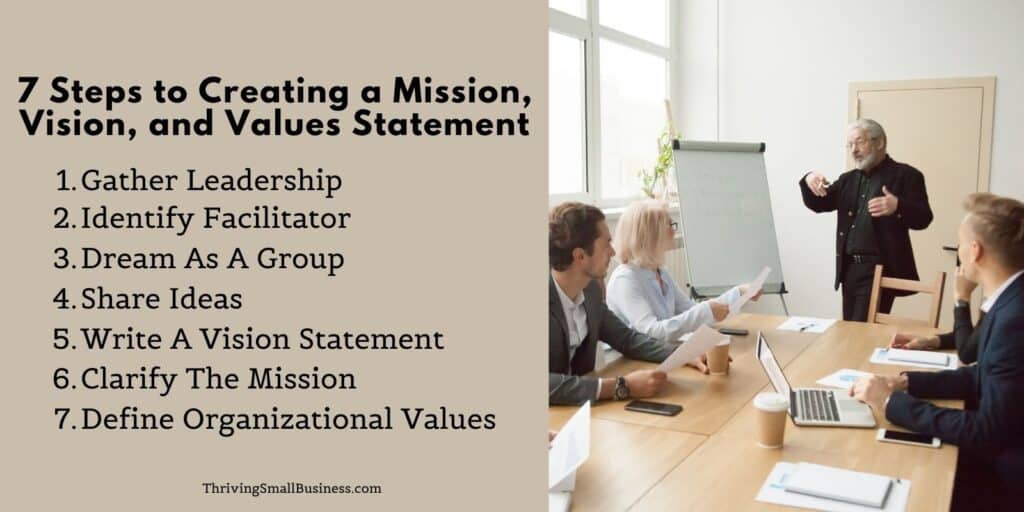How To Create A Mission, Vision, And Values Statement
Estimated reading time: 6 minutes
I was recently asked why a business needs a mission, vision, and values statement.
My response was that a mission, vision, and values statement is a tool to help an organization accomplish what it has set out to do and helps provide a framework for strategy, focus, and decision-making.
A Vision statement describes the ideal future state of the organization. It articulates what the organization is trying to accomplish.
Vision Statement Example
“ABC Auto Repair will be the premier auto shop in the
metropolitan area by providing extraordinary customer service
and high-quality auto repair that exceeds all competition.”
A Mission statement describes why the organization exists and why it does, and what it does.
Mission Statement Example
“ABC Auto Repair exists to help its customers care
for and extend the life of their automobile investments.”
A Values statement describes and lists the fundamental values and principles that the organization operates by.
Values Statement Example
“ABC Auto Repair operates by the following guiding principles:
Honesty, Integrity, Customer Service,
Quality, Diversity, and Innovation.”
Some organizations write paragraphs describing their vision.
But I think the shorter the statement, the more likely employees will be able to absorb, memorize, and ideally explain it to others.
Employees Need To Understand
Employees should have a clear understanding of what the business is trying to accomplish and why it operates as it does.
This contributes to high levels of employee engagement and employees who provide excellent customer service.
Every organization needs to understand where it is going before it can develop a strategic plan and map out steps to get there!
7 Steps to Creating a Mission, Vision, and Values Statement
1. Gather Board Level Leadership
If you don’t have a formal board, pull together an advisory team.
If you are a small business, pull in anyone who has helped you get to where you are in an advisory capacity.
Writing a vision, mission, and values statement should be an exercise that is done at the board level – with some senior-level employees.
This can be done in a retreat setting, such as a conference room of a hotel or the back room of a restaurant.
The goal is to create an environment insulated from distractions and interruptions.
2. Identify an Objective Facilitator
If the organization has strong leadership, there may be someone at the board level who can facilitate the visioning session.
Whether the facilitator is a member of the staff or is contracted through a third party, the facilitator’s role is to help drive the process without influencing the content.
An experienced facilitator will know how to do this.

3. Dream As a Group
A visioning session is a time for dreaming.
Work with flip charts or whiteboards to get the creative juices going and provide colorful visuals that help spark thoughts and ideas.
Divide into groups of 3-4 people, provide each group with a flip chart, and have them discuss and answer the following questions:
Note: There should be simultaneous groups if there is more than one group.
- Who are we?
- What do we want this organization to look like in 5, or 10 years?
- Where do we want to be in 1, 5, or 10 years from now?
- Create a headline for a newspaper about the organization ten years from now. What would it say?
This exercise should take 20-30 minutes.
4. Share Ideas
After 30 minutes, ask all groups to share the thoughts and ideas they generated.
Use the larger group to pick the best thoughts and ideas from each of the smaller groups.
Write the collective thoughts and words on a new flip chart.
Ask all participants to add, subtract, and formalize the sentence structure of the statement.
5. Examine the Statement
After the group drafts a couple of sentences, read them out loud to the entire group again.
Next, test the sentences to see if the entire group agrees that the statement reflects the organization and describes an ideal future state.
Make sure the statement is descriptive enough and is measurable to determine progress toward the vision.
6. Clarify the Mission
After the vision statement is written, go through a similar exercise to define the organization’s mission.
Remember, a mission statement describes “why” the organization exists.
Vision and mission statements should be used for decision-making to reflect the importance of what the business is trying to accomplish.
Break into small groups again and spend another 20-30 minutes brainstorming words that describe why the organization exists.
Once all the groups have their ideas down, ask them to present them to the other groups.

Using a flip chart, combine all of the ideas and, as a group, try to create a short phrase that is descriptive of why the organization exists.
The group will refine the phrase, and after it reaches a final state, read it out loud one last time so that the entire group agrees it accurately reflects why the organization exists.
7. Define Organizational Values
Once a vision and mission statement is drafted, break into groups once again and allow another 20 minutes or so to come up with a list of values.
These will become the shared values that guide the organization’s operations.
As the groups come up with their lists, ask them to present their ideas to the larger group again and then combine and agree on a single list.
The final list should ideally be 5-10 words and should be easy for people to memorize.
You did it!
You now have an articulated Mission, Vision, and Values Statement.
Next, you will have it printed and displayed in your business so your customers and employees can see your priorities and what you are trying to accomplish!
Many organizations don’t have a defined vision, mission, and values statement because they don’t know how to do it, and the process scares them.
However, if you can get the right people in the room and have a trained facilitator, it can be done in a few short hours.
Has your organization developed a Vision, Mission, and Values statement?




